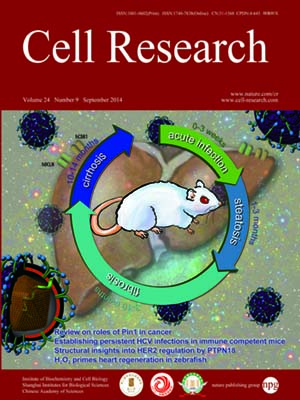
Volume 24, No 9, Sep 2014
ISSN: 1001-0602
EISSN: 1748-7838 2018
impact factor 17.848*
(Clarivate Analytics, 2019)
Volume 24 Issue 9, September 2014: 1141-1145 | Open Access
LETTERS TO THE EDITOR
Quantitative chemical proteomics reveals a Plk1 inhibitor-compromised cell death pathway in human cells
Monika Raab1,3, Fiona Pachl2, Andrea Krämer1, Elisabeth Kurunci-Csacsko1, Christina Dötsch1, Rainald Knecht3, Sven Becker1, Bernhard Kuster2,4 and Klaus Strebhardt1,4
1Department of Gynecology, School of Medicine, Goethe University, Theodor-Stern-Kai 7, 60590 Frankfurt, Germany
2Technische Universität München, Emil Erlenmeyer Forum 5, 85354 Freising, Germany
3Head and Neck Center, UKE Hamburg, Martinistr. 52, 20246 Hamburg, Germany
4German Cancer Consortium (DKTK), Heidelberg, Germany
Correspondence: Klaus Strebhardt, Tel: +49-69-6301 6894; Fax: +49-69-6301 6364(strebhardt@em.uni-frankfurt.de)
Because multiple cancers require Polo-like kinase (Plk) 1 for survival1,2,3, Plk1 has been investigated intensively as a target for novel anti-cancer agents4,5,6. Although many small molecule Plk1 inhibitors have reached the clinic, our knowledge about their target profiles is limited, because their biochemical properties are determined mostly using in vitro kinase assays. It remains unclear whether this approach reflects the true pharmacodynamic properties of Plk1 inhibitors, since these assays often address only small portions of the human kinome and typically use a recombinant kinase and an artificial substrate. In the present study, for a more comprehensive characterization of the clinical Plk1 inhibitor BI2536, we treated HeLa cells with serial dilutions of this inhibitor. At rising concentrations of up to 100 nM BI2536, we observed a significant mitotic arrest, a high percentage of rounded cells and increasing levels of cell death (Figure 1A and Supplementary information, Figure S1A). Above this drug concentration, the apoptotic activity did not further increase significantly or decreased to a small extend (Figure 1A and Supplementary information, Figure S1A), accompanied by a slight recovery of cell growth (Figure 1A and Supplementary information, Figure S1A, upper panels) and flattening of the cells as seen by microscopical inspection. This observation indicates that the drug response is biphasic and concentration-dependent with a small reduction of apoptosis at high doses compared to concentrations lower than 100 nM.
10.1038/cr.2014.86
FULL TEXT | PDF
Browse 2170


